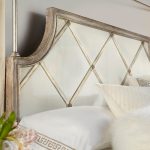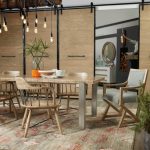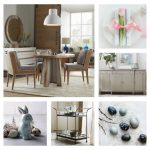
Legends Dining Room Table
The simple answer is quality. Wooden furniture (often called “casegoods”) is priced on a variety of factors, such as the wood used, stains/finishes, carvings and designs, and how it’s all put together.
I’d like to give you a few quick tips on how to judge the quality of the wooden furniture you want to buy. Maybe you’ll decide that what you need IS something cheap and temporary, but you should at least know that before plunking down your hard-earned cash for it. On the other hand, if what you want is a beautiful piece that will grace your home for many years, then you should know what to look for to find it!
Today I’ll just write about the differences in the types of wood and terminology used in casegoods, and in my next blog I’ll explain the significance of finishes, joints, overall construction, etc.
• Hardwoods: Hardwood comes from a tree with broad leaves and no needles, such as maple, cherry or mahogany. These woods have strength and stability, but those qualities can make hardwoods difficult to work with for intricate carving and detail work.
• Softwoods: Softwoods come from conifer trees such as pine or cedar. They are easily carved or worked, but that makes them more susceptible to marks and dings as well.
• Solid wood: The term “solid wood” is used to distinguish between ordinary lumber and engineered wood, and refers to pieces that do not have hallow spaces. Some furniture will be advertised as using solid wood, but this often indicates that all exposed pieces of the piece are solid wood, and those areas hidden from view may be another material. Solid woods are very attractive and have the advantage of being easily refinished. Many of today’s casegoods pieces are a combination of solid woods (providing strength to frames, legs and other supporting components) and veneers, applied to solid wood or wood composition material.
• Plywood: Plywood is a type of manufactured solid wood made from thin sheets of hardwoods or softwoods, and it is then glued together for greater strength. Solid wood expands and contracts as the humidity changes, and it doesn’t offer the needed stability when constructing large flat panels (like table tops or cabinet sides). Plywood won’t split because of the cross grain plies and unlike solid wood is very strong in any direction. These panels will often be framed in solid wood and covered by veneers to recreate the look of one large piece of wood.
• All wood: “All wood” describes engineered wood, including plywood, particleboard or fiberboard. Fiberboard is created by breaking down wood chips into fibers and mixing these with an ultra-strong adhesive. When fused under intense heat and pressure, the resulting panel has consistent, uniform strength, is resistant to warping, cracking and splitting, and has no knots or other surface imperfections. Particleboard is a term used for low-density fiberboard, made from wood chips, sawmill shavings, or even saw dust. It is very prone to expansion and discoloration due to moisture, particularly when it is not covered with paint or another sealer.
• Veneers: A veneer is simply a thin layer of decorative wood, chosen for beauty and character, then glued or bonded to another wood surface. Veneers are not a substitute for stable wood construction, but bonding a veneer to another surface creates extra strength and makes it possible to match grain patterns or use inlays to create beautiful designs that do not occur naturally in solid woods.
Whew! Did you get all that? You can learn more about quality cues for wood furniture in the Quality Cues Section of our website.
http://www.hookerfurniture.com/images/why_buy/quality_story.pdf
Do you have any good/bad experiences with any of these types of woods? Any recommendations for fellow shoppers?











{ 1 comment… add one }
Hello, really informative blog post ! waiting for more from you 🙂 Going to subs.